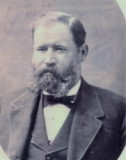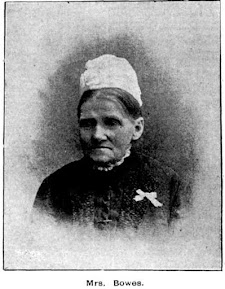Standing on the remnants of a Grand Estate!
When I attended my grand niece's 4th birthday celebration recently, little did I know I was standing on the grounds of the former estate owned by the, allegedly, richest man in Ashfield who also founded Canterbury Racecourse and lived in one of the largest mansions in the area but who also happens to call Rookwood 'home".
FREDERICK CLISSOLD
Frederick was born in 1831 in Gloucestershire England to John, a farm labourer, and Sarah. The family arrived on the "Layton" in January 1838, a ship plagued by a measles epidemic that took the life of his younger sister. The family settled in the inner city suburb of Glebe and more children followed.
Frederick Clissold - ancestry.com public access
John found work at the Robert Cooper distillery and Frederick was educated at Grantham House Academy near his home. John left the distillery and set up as a fellmonger, a person dealing with removing wool from sheepskins, in the Blackwattle Swamp area. Frederick joined the business after leaving school, learning enough about it to join the wool firm of James Henry Atkinson (the subject of a future blog!).
Sarah committed suicide in 1847 and John was declared bankrupt in 1850. Upon John's death, Frederick carried on the business with his partner, George Hill, moving it several times until settling on a site opposite the Australian Sugar Company's Mill in Canterbury. During this time he married Caroline Huxley and after her death in 1869, he soon married Ann Broomfield, with whom it would appear he had already fathered two children.
Australia Sugar Company Mills Canterbury @ 1940's - Wikipedia
Frederick and his young family moved to Ashfield in 1872 and lived in "Mountjoy" in Victoria Street. It was also in that year he was elected to the first Ashfield Council as one of six aldermen.
"Mountjoy" as at April 2021 - photograph author's own
Horse racing was popular in the Canterbury region from @ 1852 when part of the Sugar Mills land was cleared for use as a racecourse. After a lapse of some years, racing began again in 1871, when Frederick Clissold and Thomas Austen Davis organised a meeting on land leased by Davis in the vicinity of the present racecourse. Over 300 mainly local residents attended.
In 1878, a crowd of 3,000 attended a meeting to celebrate Queen Victoria's Birthday which was successful and in 1884 the present site became the headquarters of the Canterbury Park Race Club and gardens. Frederick was one of the directors of the race club. The first meeting on Saturday 19 January 1884 boasted an attendance of 3,000 people with special trains to Ashfield and horse buses conveyed visitors to the race course. Suffice to say it still operates to this day.
During this time one of Frederick's acquisitions was the house "Farleigh" on a very large block of land bounded by present day Clissold Street, Holden, Queen and Seaview Streets. The land was subdivided into 51 lots in 1881 and the family moved to "Farleigh" around 1883 where Frederick managed his next project on Victoria Street.
The mansion "Glentworth", the largest house in Ashfield, was completed in 1887 and still stands on the highest part of that street as a showpiece of the area at the corner of Victoria and Clissold Streets.
"Glentworth" as at April 2021 - photograph author's own
Annie continued to live at "Glentworth" for twenty years before selling the mansion to the Sisters of the Good Shepherd who added a chapel in 1942. The home is now part of the Cardinal Freeman Retirement Village, albeit a very grand retirement home!
"Farleigh" was originally built on the corner of Clissold and Queen Street. The grounds were subdivided in 1881, again in 1891 and further subdivided in 1911. There are two storey terrace houses and other houses built in the 1880-90’s with some Federation and Inter-War period homes.
1881 sale of Farleigh Estate - Inner West Council
It would appear that the grounds on which the Inter-War home stands that I attended was the front garden (or possibly side one) and orchard for a large two storey home built in the first allotment division in 1881 and that home is listed as a significant Heritage item. The re-subdivision in 1911 by Richardson & Wrench showed all the remaining further sub-divisions of 11 lots were sold in February of that year. It seems that "Farleigh" itself had been destroyed in 1910.
This part of Ashfield is quite a treat for those that love gazing upon homes from all eras from Victorian through to the present day with many examples of every period in its streets. I think it's time for another stroll of the area.
Frederick Clissold was one of the many people who were in the right place and right time to improve his way of living. The son of a labourer to one of the richest men in the area in a period of just over 40 years is some achievement!
Frederick is buried in Rookwood in a prominent position on Necropolis Drive near the old Mortuary No.1 Station site with his second wife, Annie. His father John's second wife Elizabeth "Betsy" is also buried with him. John lies in Camperdown Cemetery Newtown.
Monument at Frederick Clissold burial plot - author's own
Please feel free to comment below or at the group facebook page which you can find by searching rookwoodcemeterydiscoveries.blogspot.com









Another great read, with beautiful pictures…looking forward to your next “blog”…
ReplyDeleteI hope you have stayed with me - I'm on to no. 106
Delete